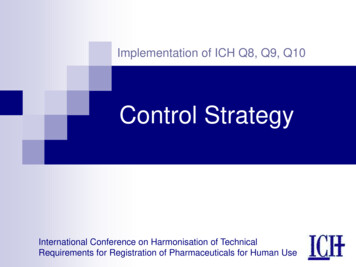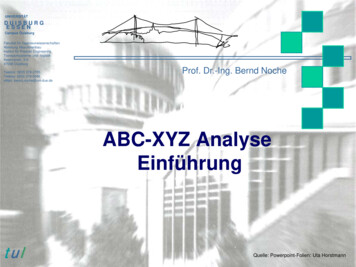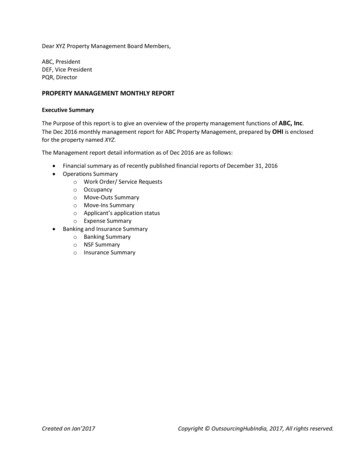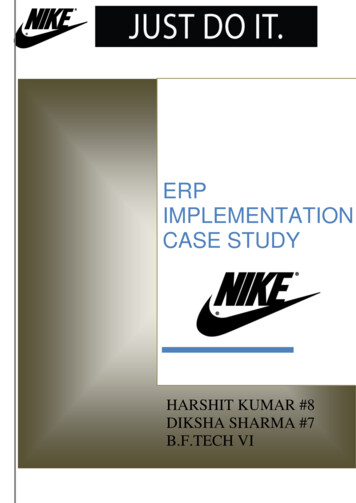
Transcription
Implementation of ICH Q8, Q9, Q10Control StrategyInternational Conference on Harmonisation of TechnicalRequirements for Registration of Pharmaceuticals for Human Use
ICH Quality Implementation Working Group - Integrated Implementation Training WorkshopBreak out B: Control StrategyIntroduction Structure of this session- Discussion of key messages on Control Strategy- Examples from the Case Study- Wrap up- Breakout report ICHslide 3
ICH Quality Implementation Working Group - Integrated Implementation Training WorkshopBreak out B: Control StrategyKey Messages - Definitions ‘Control Strategy is a- Planned set of controls,- Derived from current product and process- ICHunderstanding that assures process performance andproduct qualityThe controls can include parameters and attributesrelated to drug substance and drug product materialsand components, facility and equipment operatingconditions, in-process controls, finished productspecifications, and the associated methods andfrequency of monitoring and control.’ (ICH Q10)slide 4
ICH Quality Implementation Working Group - Integrated Implementation Training WorkshopBreak out B: Control StrategyKey Messages - Definitions Critical Quality Attribute (CQA):A physical, chemical, biological or microbiologicalproperty or characteristic that should be within anappropriate limit, range, or distribution to ensure thedesired product quality (Q8(R2)) Critical Process Parameter (CPP):A process parameter whose variability has an impact ona critical quality attribute and therefore should bemonitored or controlled to ensure the process producesthe desired quality (Q8(R2)) ICHslide 5
ICH Quality Implementation Working Group - Integrated Implementation Training WorkshopBreak out B: Control StrategyKey Messages - Definitions In-Process Control (or Process Control):Checks performed during production in order to monitor and,if appropriate, to adjust the process and/or to ensure that theintermediate or API conforms to its specifications (Q7)Applies similarly to the drug product In-Process Tests:Tests which may be performed during the manufacture ofeither the drug substance or drug product, rather than aspart of the formal battery of tests which are conducted priorto release (Q6A) ICHslide 6
ICH Quality Implementation Working Group - Integrated Implementation Training WorkshopBreak out B: Control StrategyKey Messages - Definitions ‘Real time release testing (RTRT)is the ability to evaluate and ensure the quality of in-processand/or final product based on process data, which typicallyinclude a valid combination of measured material attributes andprocess controls’ (Q8(R2)) Process Analytical Technology (PAT):A system for designing, analyzing, and controlling manufacturingthrough timely measurements (i.e., during processing) of criticalquality and performance attributes of raw and in-process materialsand processes with the goal of ensuring final product quality(Q8(R2)) ICHslide 7
ICH Quality Implementation Working Group - Integrated Implementation Training WorkshopBreak out B: Control StrategyKey Messages 1/5 Control strategy derives from management of risk and should lead to assurance of consistent quality of productin alignment with the Quality Target Product Profile(QTPP)Control strategy is:- Not a new concept- Not just specifications- Based on product and process understanding andrisk management- While space is optional, control strategy is not. ICHslide 8
ICH Quality Implementation Working Group - Integrated Implementation Training WorkshopBreak out B: Control StrategyKey Messages 2/5 Every process and product has an associated control strategy.- There is one overall control strategy for a given product.- There are control strategies for unit operations- It could include some site specific aspectsFor a given product, different approaches for the controlstrategy are possible (e.g. in-process testing, RTRT, endproduct testing) Specifications for API and drug product are stillneeded for stability testing, regional regulatory testingrequirements, etc. ICHslide 9
ICH Quality Implementation Working Group - Integrated Implementation Training WorkshopBreak out B: Control StrategyKey Messages 3/5 Control strategy and batch release should not be confused.Control strategy is a key component, but not the onlyelement needed for the batch release decision. Scale-up, technology transfer and manufacturingexperience can lead to refinements of the control strategyunder the PQS considering regulatory requirements ICHslide 10
ICH Quality Implementation Working Group - Integrated Implementation Training WorkshopBreak out B: Control StrategyKey Messages 4/5 Process for defining the control strategy-What are the quality criteria (QTPP)Initial design of specific product & processAssess prior knowledge to understand materials, process andproduct with their impact- Experience with different approaches to control- Risk assessment for process steps and variables- Assure all CPPs are identified during QRA- Development to further determine what type of controls areappropriate for each variable- Consider design space, if submitted- Specifications Scale-up considerations Quality system requirements of control strategy- Implementation, maintenance and updating ICHslide 11
ICH Quality Implementation Working Group - Integrated Implementation Training WorkshopBreak out B: Control StrategyKey Messages 5/5 Industry selects control approach based on multiple factors- Factors may include analytical testing sensitivity,equipment limitations, etc.Regulators evaluate the control strategy and whether therisk has been adequately controlledInspector reviews the implementation of the controlstrategy at site, including adaptation at scale up, and theadequacy of the site quality system to support it ICHslide 12
ICH Quality Implementation Working Group - Integrated Implementation Training WorkshopBreak out B: Control StrategyExamples from the Case Study Review of QTPP and Drug Product Risk Assessment Blending Process Control OptionsDecision on conventional vs. on-line testing Tablet weight control during compression ICHslide 13
ICH Quality Implementation Working Group - Integrated Implementation Training WorkshopBreak out B: Control StrategyQuality Target Product Profile (QTPP)Safety and Efficacy RequirementsSakura TabletDoseSubjective PropertiesPatient Safety – chemical purityPatient efficacy –Particle Size Distribution (PSD)Chemical and Drug ProductStability:2 year shelf life(worldwide 30ºC)Characteristics /RequirementsTranslation intoQuality Target ProductProfile (QTPP)30 mgIdentity, Assay and UniformityNo off-taste, uniform color,and suitable for global marketAppearance, elegance, size,unit integrity and othercharacteristicsImpurities and/or degradatesbelow ICH or to be qualifiedAcceptable hydrolysis degradatelevels at release, appropriatemanufacturing environmentcontrolsPSD that does not impactbioperformance or pharmprocessingDegradates below ICH or to bequalified and no changes inbioperformance over expiry periodAcceptable API PSDDissolutionHydrolysis degradation &dissolution changes controlledby packagingQTTP may evolve during lifecycle – during development and commercial manufacture – as new knowledgeis gained e.g. new patient needs are identified, new technical information is obtained about the product etc. ICHslide 14
ICH Quality Implementation Working Group - Integrated Implementation Training WorkshopBreak out B: Control StrategyQuality Risk AssessmentImpact on Assay and Content Uniformity CQAs QRA shows API particle size, moisture control, blending and lubricationsteps have potential to affect Assay and Content Uniformity CQAs-Moisture is controlled during manufacturing by facility HVAC control of humidity(GMP control)Drugsubstanceparticle sizeMoisturecontent Packagingin vivo performanceDissolutionAssayDegradationContent ability-physical- Low risk- Medium risk- High risk ICHKey message: Initial QRA identifies where to focus Developmentefforts to understand and control Assay and Content Uniformity CQAsslide 15
ICH Quality Implementation Working Group - Integrated Implementation Training WorkshopBreak out B: Control StrategyBlending Process Control OptionsDecision on conventional vs. RTR testingKey message: Both approaches to assure blend uniformity are valid in combinationwith other GMP requirements ICHslide 16
ICH Quality Implementation Working Group - Integrated Implementation Training WorkshopBreak out B: Control StrategyProcess Control Option 2Blend uniformity monitored using a process analyser Control Strategy to assure homogeneity of the blend- Control of blendingend-point by NIRand feedback controlof blender- API particle sizeIn this case study, thecompany chooses to useonline NIR to monitor blenduniformity to provideefficiency and more flexibility ICHslide 17
ICH Quality Implementation Working Group - Integrated Implementation Training WorkshopBreak out B: Control Strategy ICHslide 18
ICH Quality Implementation Working Group - Integrated Implementation Training WorkshopBreak out B: Control Strategy ICHslide 19
ICH Quality Implementation Working Group - Integrated Implementation Training WorkshopBreak out B: Control StrategyRTRT of Assay and Content Uniformity Finished Product Specification – use for stability, regulatorytesting, site change, whenever RTR testing is not possible-Assay acceptance criteria: 95-105% of nominal amount (30mg)Uniformity of Dosage Unit acceptance criteriaTest method: HPLC Real Time Release Testing Controls- Blend uniformity assured in blending step (online NIR spectrometer for-blending end-point)API assay is analyzed in blend by HPLCTablet weight control in compression step No end product testing for Assay and Content Uniformity (CU)- Would pass finished product specification for Assay and Uniformity ofDosage Units if tested because assay assured by combination of blenduniformity assurance, API assay in blend and tablet weight control (if blendis homogeneous then tablet weight will determine content of API) ICHslide 20
ICH Quality Implementation Working Group - Integrated Implementation Training WorkshopBreak out B: Control StrategyTopics to discuss using this Case Study What are the steps in building the control strategy elements forcontent uniformity?-Does this connect with the control strategy elements for anotherCQA (e.g. potency)?How does this fit into the overall control strategy of the productCQA’s? What are the benefits in this blending example of the different control strategy options?Is this control strategy adequate to assure assay and contentuniformity of the final product? Can it replace end producttesting for these CQA’s?What could be alternative approaches to the proposed controlstrategy? ICHslide 21
ICH Quality Implementation Working Group - Integrated Implementation Training WorkshopBreak out B: Control StrategyAdditional discussion questions What could the drug product specification bepresented in the application file when RTRT isemployed? What might a certificate of analysis look like for aproduct that is released via RTRT? ICHslide 22
ICH Quality Implementation Working Group - Integrated Implementation Training Workshop slide 4 Break out B: Control Strategy Key Messages - Definitions ‘Control Strategy is a -Planned set of controls, -Deri











